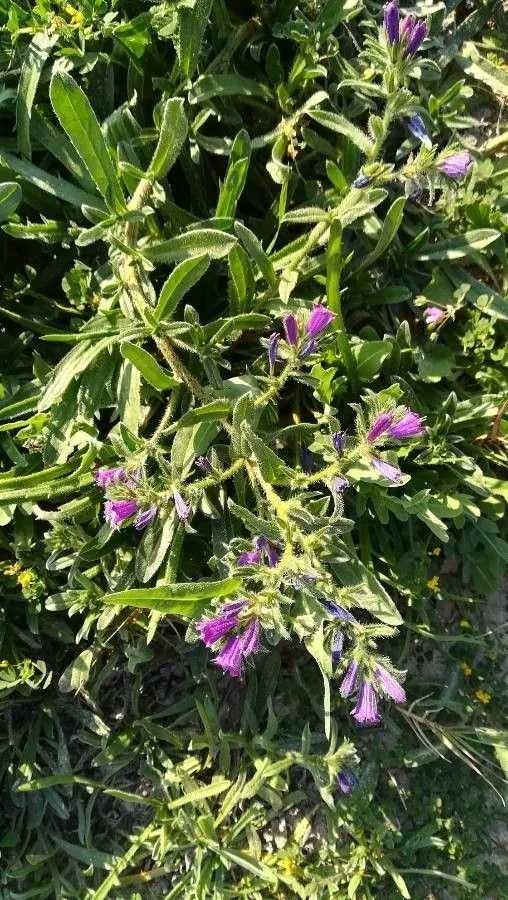
Author: Pomel
Bibliography: Nouv. Mat. Fl. Atl. 1: 90 (1874)
Year: 1874
Status: accepted
Rank: species
Genus: Echium
Vegetable: False
Observations: W. & S. Medit.
The plant commonly known as Sand viper’s gloss, scientifically identified as Echium sabulicola, belongs to the Boraginaceae family. This captivating species is noteworthy for its adaptability to specific Mediterranean habitats, characterized predominantly by its presence in the western and southern Mediterranean regions.
First documented in the year 1874 by the renowned botanist Pomel, Echium sabulicola was described in “Nouvelles Matériaux pour la Flore Atlantique,” a comprehensive botanical work that remains a vital resource in understanding North African and Mediterranean flora.
The Sand viper’s gloss is an herbaceous plant with distinct features that contribute to its unique beauty and resilience. Bearing the characteristic traits of the Boraginaceae family, it often displays vibrant inflorescence that attracts various pollinators, playing a significant role in the local ecosystem. The name “viper’s gloss” may allude to the snake-like appearance of its flowers or its historical usage in folk medicine for treating snake bites.
Adapted to sandy soils, Echium sabulicola thrives in regions with well-drained, nutrient-poor conditions where other plants might struggle. This specific ecological niche showcases the plant’s ability to survive and prosper in a challenging environment, making it an interesting subject for studies on plant resilience and adaptation.
As with many members of the Boraginaceae family, Sand viper’s gloss holds potential not only for ecological studies but also for horticultural interest, given its striking appearance and hardy nature. Its resilience to sandy and coastal conditions might offer insights for sustainable landscaping practices in similar climates.
In summary, Sand viper’s gloss (Echium sabulicola) is a remarkable Mediterranean plant with both ecological significance and aesthetic appeal. Documented by Pomel in 1874, this member of the Boraginaceae family continues to captivate botanists and horticulturists alike, further enhancing our understanding of plant adaptation and survival in specific environmental niches.
En: Sand Viper’s Gloss
Ca: Èquium marítim
Fr: Vipérine maritime, Vipérine marine
It: Viperina delle spiagge
Es: Viborera Marítima
: Sand viper’s gloss
Taken Jul 8, 2022 by Monteiro Henrique (cc-by-sa)
Taken Jul 8, 2022 by Monteiro Henrique (cc-by-sa)
Taken Apr 21, 2015 by Tela Botanica − Hervé Goëau (cc-by-sa)
Taken May 17, 2022 by Yporquenounblog Palantir (cc-by-sa)
Taken May 2, 2015 by Fernando Lozano (cc-by-sa)
Taken Nov 1, 2022 by Diego Alex (cc-by-sa)
Taken May 30, 2022 by Sara Martin (cc-by-sa)
Taken Oct 12, 2020 by Montse León (cc-by-sa)
Taken Aug 8, 2014 by Tela Botanica − Hervé Goëau (cc-by-sa)
Taken Apr 21, 2015 by Tela Botanica − Hervé Goëau (cc-by-sa)
Taken Jul 10, 2022 by Jacques Zuber (cc-by-sa)
Taken Jul 22, 2020 by Nathalie Potel (cc-by-sa)
Taken Apr 21, 2015 by Tela Botanica − Hervé Goëau (cc-by-sa)
Taken Feb 19, 2020 by Boyero Arantxa (cc-by-sa)
Taken Mar 27, 2021 by Santoyo Javier (cc-by-sa)
Taken Mar 29, 2022 by Francesc Riudavets (cc-by-sa)
Taken Apr 15, 2011 by Photoflora – Benoit BOCK (©)
Taken Apr 23, 2021 by João Serra (cc-by-sa)
Taken Jan 1, 1970 by Photoflora – L’Abbé COSTE (©)
Taken Nov 30, 2021 by Joan Panadès (cc-by-sa)
Taken May 2, 2022 by Eva Virago (cc-by-sa)
Taken Apr 21, 2015 by Tela Botanica − Hervé Goëau (cc-by-sa)
Taken Apr 21, 2015 by Tela Botanica − Hervé Goëau (cc-by-sa)
Taken Aug 8, 2014 by Tela Botanica − Hervé Goëau (cc-by-sa)
© copyright of the Board of Trustees of the Royal Botanic Gardens, Kew.
Ph maximum: 7.0
Ph minimum: 6.5
Light: 8
Atmospheric humidity: 3
Soil nutriments: 6
Family: Myrtaceae Author: (F.Muell.) K.D.Hill & L.A.S.Johnson Bibliography: Telopea 6: 402 (1995) Year: 1995 Status:…
Family: Rubiaceae Author: Pierre ex A.Froehner Bibliography: Notizbl. Bot. Gart. Berlin-Dahlem 1: 237 (1897) Year:…
Family: Sapindaceae Author: Koidz. Bibliography: J. Coll. Sci. Imp. Univ. Tokyo 32(1): 38 (1911) Year:…
Family: Asteraceae Author: A.Gray Bibliography: Pacif. Railr. Rep.: 107 (1857) Year: 1857 Status: accepted Rank:…
Family: Fabaceae Author: Medik. Bibliography: Vorles. Churpfälz. Phys.-Ökon. Ges. 2: 398 (1787) Year: 1787 Status:…
Family: Aspleniaceae Author: (Cav.) Alston Bibliography: Bull. Misc. Inform. Kew 1932: 309 (1932) Year: 1932…